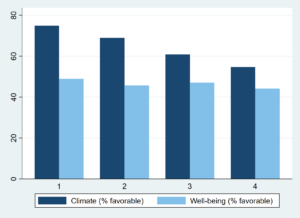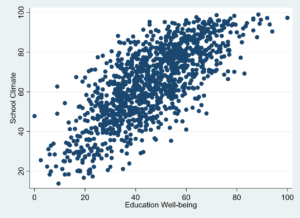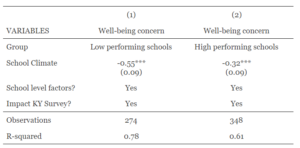At this moment, it is critically important that we turn our attention to the well-being of educators and students. The pandemic brought with it anxiety, disruption, and uncertainty and exacerbated the anxiety that was already present in schools. Collectively, we have experienced significant trauma and we know that the experience of surviving a pandemic is already showing up in schools in many ways.
At the Kentucky Education Summit, there was a panel of students sharing what they had learned from a series of focus groups with their peers about mental health. One student shared something that will stick with me. He said (and I’m paraphrasing): “We students are not ok. But we also see that our teachers are not ok. And that makes it hard to feel like we can go to them for help.” This statement demonstrates the importance of focusing on supporting the well-being of both students and educators.
While much of this is out of our control (who could have predicted the pandemic and how it affected all of us?), our team set out to understand what factors can be addressed to shift educator well-being. In this study, we examine one potential contributor to educators’ emotional well-being: school climate.
Key terms:
Educator Well-being: a wide-encompassing idea that includes teacher mental, physical, emotional, and spiritual health. Individual, school and community factors influence teacher well-being. For this study we focus on emotional well-being.
School climate: The quality and character of school life. School climate is based on patterns of students’, parents’, and school personnel’s experience of school life and reflects norms, goals, values, interpersonal relationships, teaching and learning practices, and organizational structures (National School Climate Center).
Last month we published our first brief about educator emotional well-being. Using the 2019 Impact Kentucky survey data we found that the majority of educators express concern about their emotional well-being and the well-being of their colleagues as a result of their work. In this study we build on that work by testing the hypothesis that schools with a more positive school climate have lower levels of concern about emotional well-being.
Here’s what we found:
- Educators answered less favorably about emotional well-being than school climate. This is true across all school levels, as shown in the graph below.

column 1 = early childhood centers | column 2 = elementary schools | column 3 = middle schools | column 4 = high schools
2. School climate and emotional well-being are correlated. When educators in a school reported more favorable school climate, they also felt more positively about emotional well-being. The scatter plot below shows a clear, positive trend. While the correlation is strong (0.7), this doesn’t necessarily mean it’s causal.

- However, using regression to control for other factors, we found that school climate, more than any other factor, predicts educator concern about emotional well-being. Not only was the effect significant, the effect size was large: a one standard deviation increase in school climate was associated with a 45 percent decrease in educator concern about emotional well-being. That means that in schools with more positive school climate, teachers are less concerned about their emotional well-being and the emotional well-being of their colleagues.
- Climate matters more for educator well-being in low-performing schools than in high-performing schools. The table below shows that the effect of more positive school climate for relatively low-performing schools (schools in the 25th percentile or lower) compared to the effect of school climate on educator well-being among relatively high-performing schools (schools in the 75th percentile or higher statewide).

So what can educational leaders do with these results?
At the school level:
- Assess Current School Climate and Identify Priorities. Diagnosing the current state of school climate is key to driving improvement efforts. There are many instruments for doing this, including the Yale School Climate Walkthrough, and the School Climate Surveys in the wealth of guides and training tools from the U.S. Department of Education. In Kentucky, district and school leaders can utilize the Impact Kentucky Survey results to assess specific areas of climate and educator well-being in need of prioritization. Leaders and teachers can also use the Student Thriving Index within Infinite Campus to help identify areas of student well-being in need of targeted, intentional support.
- Implement intentional and strategic practices to cultivate connection and positive relationships between people in schools. One powerful evidence based tool is called the Compassion Resilience Toolkit. This free, well-designed toolkit was co-created by education practitioners and researchers who study well-being. The purpose is to support building of resilience for educators and minimizing compassion fatigue in an overstressed system. Another unique tool is COR Classrooms, a suite of online learning modules focused on building positive relationships with students. The COR model addresses the essential pieces of a relationship and how they work together. Understanding this model empowers teachers to pay close attention to the different factors influencing their relationships, which in turn will help them form stronger and more positive connections with students.
- Incorporate a Trauma Responsive Approach for Students and Staff. We are increasingly understanding the effects of trauma on student learning, behavior, and school climate. In Kentucky, the School Safety and Resiliency Act requires that districts and schools have a trauma informed plan to support students who experience trauma and the teachers who experience secondary traumatic stress while supporting them. When adults in school buildings are trained in utilizing trauma responsive practices, they are better able to recognize the signs and symptoms of trauma, respond appropriately, and connect them with the resources needed. This approach makes schools feel more human-centered, supportive, and safe for kids and staff – all of which will drive improvements in school culture. To build your school’s capacity for trauma responsiveness you can access information about Kentucky district and school trauma informed plans and the trauma informed toolkit, as well as request training for your staff. Additionally, the Trauma Responsive Educator Project offers a wide range of very practical and user friendly tools and resources for supporting a trauma responsive approach.
- Integration of Social and Emotional Learning (SEL). School climate is inextricably linked with social and emotional learning. As school climate improves, students and adults alike increase their social and emotional capacities, and a positive school climate creates the conditions conducive for social and emotional learning (Darling-Hammond, 2018). The Collaborative for Academic, Social, and Emotional Learning (CASEL) offers a rich array of free resources on ways to implement SEL at every level of the education system, and the KDE Social, Emotional and Behavioral Learning/Health page has a wealth of resources. While implementing a systems approach to this work is key, even small kernels of practice can be beneficial for individuals. For quick strategies, you can also access this bank of SEL activities from InspireEd to support student SEL development, and this adult SEL toolkit and this bank of evidence based practices for supporting educator well-being and SEL.
District Level Strategies:
- District Level Efforts to Support Positive Climate. From a systems perspective, districts play a critical role in prioritizing, resourcing and supporting school climate in schools. Consider this School Climate Improvement Toolkit (Caskey, 2016) that was developed to be used by district level teams to ultimately identify high leverage activities towards improving school climate system-wide. In addition to using data to assess school climate to target specific supports for specific schools, district personnel would benefit from intentionally spending time regularly “on the ground” in schools to ensure that efforts are collaborative and informed by what is actually happening. Importantly, it is not about mandating and monitoring, but instead about connection and relevant support. Regardless of initiatives that are implemented, being intentional about structuring them so that people and relationships are put first is key.
- Supporting a Tiered Systems Approach in schools, with an emphasis on a healthy culture and positive climate as critical to Tier 1. By now, most school systems have adopted to some degree a multi-tiered approach to supporting safe schools and positive student behavior, such as Positive Behavior Interventions and Supports (PBIS) and Multi-tiered Systems of Support (MTSS). However, so much attention and support is spent on “putting out fires” at tiers 2 and 3, that often addressing Tier 1 substantively becomes very difficult. Ensure a strong foundation by supporting solid Tier 1 systems and norms in schools. For information about this support in Kentucky check out the PBIS and MTSS resources.
- Explore practice and policy changes that support the whole person. District leaders should consider adopting a whole child approach to teaching and learning. This type of approach improves the safety and security of learners as humans, thereby improving school culture and the well-being of teachers and staff school wide. A first step to implementing this type of approach is to build your own knowledge and capacity of whole child policies by reading this paper from the Learning Policy Institute.
The findings presented in this paper suggest that improving school climate is one way to improve educator emotional well-being. School and district leaders should think critically about the current state of their own school culture and the emotional well-being of their staff. Then, leaders should take this reflection to determine the highest leverage strategy to improve their school’s culture and the emotional well-being of their educators.
